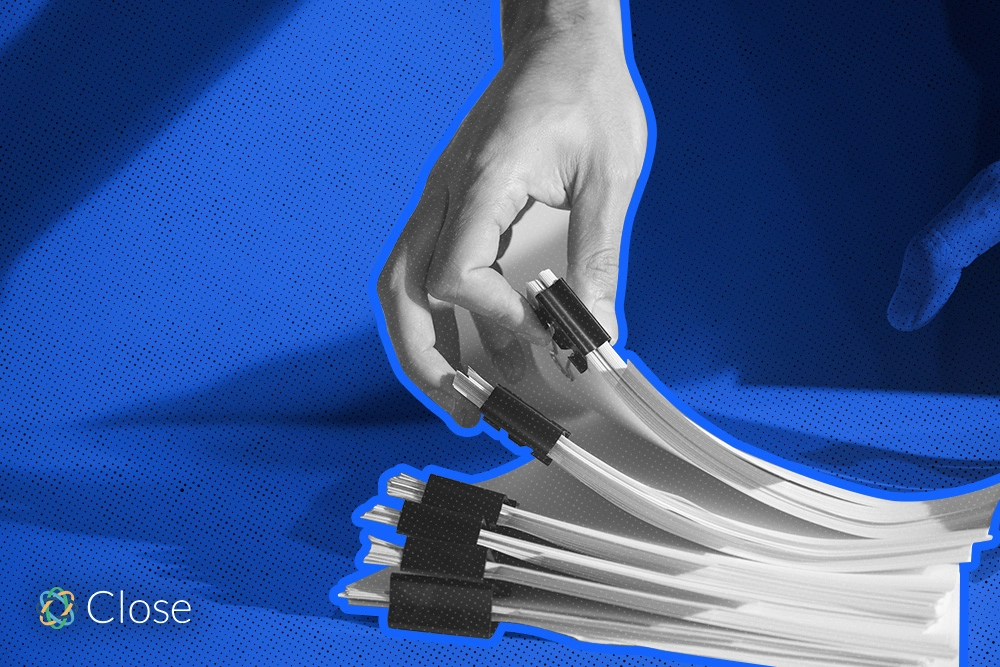
Sales used to be so simple.
Walking into an office, laying your sales pitch on the table, and getting a fast yes or no.
Today, we live in a world of diverse communication methods, and a “rule of thirds” has emerged where traditional, remote, and self-service purchases are all part of the B2B buyer journey.
 |
(Source)
To fit into this world of multiple sales channels, many teams are turning to an omnichannel CRM to cover all their needs.
Wondering what this is and how it can help your sales process? Let’s discuss:
- What is an omnichannel CRM?
- 5 ways an omnichannel CRM can improve your sales process
- How to decide on the best omnichannel sales platform for your team: 6 key factors
What is an omnichannel CRM?
An omnichannel CRM is a sales platform that unifies communication with your customers and prospects in one view. With all communication held or stored in a single platform, your conversations are seamless whether by phone, email, videoconferencing, SMS, carrier pigeon, morse code, telegram…
The goal of omnichannel communication is to support your customers wherever they are. Not only is this good business practice—it’s becoming the standard of what customers expect from brands.
And yes, this is true for B2B buyers as well. In fact, recent surveys show that B2B buyers use an average of 10 channels throughout the buying journey, up from an average of 5 in 2016.
An omnichannel sales platform—like a communication-focused CRM—makes it easier for your team to work within this strategy. All customer data is stored in one, easy-to-access place, and conversations can be continued across different channels without interruption.
Without an omnichannel CRM, your team is left scrolling through email threads to find important information, losing key answers to qualification questions in phone calls that were never recorded or logged, or failing at negotiations because nobody remembers exactly what promises were made in the last conversation.
LEARN HOW TO BUILD A SALES CRM ON YOUR OWN→
Omnichannel or multichannel CRM: what’s the difference?
Similar wording, different meaning.
A multichannel CRM allows your sales team to communicate on different channels. But an omnichannel CRM brings those communications together in an integrated view. This helps align your messaging and create smooth conversations throughout the buyer journey.
For example, imagine this process:
- While browsing a website, you start using a chatbot. The chatbot asks you some basic qualifying questions and eventually directs you to talk to a rep.
- The rep comes into the live chat and asks you the same qualifying questions before continuing with the conversation.
- Eventually, you book a call, specifying that you want to know more about a certain feature.
- A different rep calls you and starts asking you general questions about your company and goals. At the end of the call, you book a product demo.
- In the product demo, the rep spends very little time talking about the feature you wanted to know about.
- You ask questions about that feature, and the rep offers to set up a separate meeting with a more technical team member who can explain it better.
…and it goes on. While the process was multichannel, it wasn’t omnichannel. Each interaction in a different channel was like starting fresh again, and the sales reps didn’t have the historic view of the conversation they needed to streamline this process.
It’s clear: an omnichannel sales platform means more than the possibility to communicate on different channels—it involves bringing those channels to one place.
5 ways an omnichannel CRM can improve your sales process
Still wondering how an omnichannel CRM can make a difference for your team? Let’s discuss 5 benefits you’ll see by implementing an omnichannel CRM.
1. Creates a seamless customer experience throughout the sales process
As we saw in the example above, a sales process that’s done on different channels without the help of a CRM can come off as disjointed, frustrating, and unprofessional.
On the other hand, having all the historic data of a customer at hand means you can simply continue the conversation, even if you’re starting on a new communication channel.
2. Optimizes seller time by collating customer data
Qualifying questions and research take up a good deal of time for sales reps. If they’re repeating these processes over again for the same customer, that’s a serious drain on their time—never mind the time they spend logging information from one platform into another.
With a unified system, reps save time and handoffs between sales development teams, account executives, and customer success reps become much smoother and less time-consuming.
Discover the profound impact of CRM benefits on your sales process.
3. Adapts your sales process to accommodate different buyer behaviors and journeys
Buyer journeys are not linear. Each individual may go about the process in a different way, and will probably come into contact with your company various times before they actually have a ‘sales conversation’.
With an omnichannel CRM, your team can be present where and when your customers prefer, and those touchpoints are stored and visible.
This is no longer optional for your business: McKinsey reports that 80% of B2B buyers will consider moving to a different solution if they don’t get a consistent experience across channels.
 |
4. Improves sales cycles
Disjointed conversation equals wasted time. When you smooth out the process and give your whole team context on the deals they’re closing, the time to close will naturally be much faster.
If you’re having trouble managing your sales cycles, an omnichannel CRM may be the solution.
5. Helps improve new rep onboarding time
New reps need to learn the system you use and the strategies you’re using within that system. Teaching them one unified system for communication with customers is much faster than teaching them disparate systems and the never-ending task of logging that data into the CRM.
New sales hires also need to jump into closing deals. Without context and historic data, they’ll be lost and waste time trying to catch up.
Convinced that your team needs an omnichannel CRM? Let’s see what you should be looking for.
(Psst… Looking for more in-depth help to pick a new CRM? Get our CRM Buyer’s Guide.)
How to decide on the best omnichannel sales platform for your team: 6 key factors
There are plenty of CRMs that boast the ability to support an omnichannel sales strategy. So, how do you choose the right one for your team?
Start by building out your customer journeys and identifying the key touchpoints. That will help you determine which channels are truly necessary for your omnichannel sales system, and which ones are nice-to-have.
Once that’s done, check for these top features:
1. Native multichannel communication capabilities or fully-fledged integrations
Since communication is the key to an omnichannel strategy, this is the first step to evaluating the different options.
While most CRMs offer more than one way to communicate with customers, you need to identify which tool has the easiest access to all the communication channels your customers prefer.
For example, let’s say one of your main communication channels is Zoom. In that case, a CRM like Close with a native Zoom integration would be great. That means you can schedule, start, run, and record your Zoom meetings, all within your CRM.
 |
Native communication inside the CRM is ideal, but remember that a good integration is often better than a half-baked native feature.
For example, many sales teams are using chatbots and live chat for sales communication. And while some CRMs offer live chat as an add-on, the tools that were originally built for this functionality will always perform better.
That’s why Close integrates smoothly with Drift and Intercom, meaning your conversations with customers are saved and you get the context you need when you need it.
2. Cross-channel interaction history that’s visible to the whole team
Having a historic view is what gives your team the context they need to close deals smoothly. Any omnichannel CRM worth its salt should give your whole team a historic view of every interaction the team has had with a certain lead.
In Close, that looks like this:
 |
With this view, reps aren’t searching for data in one system while starting a call or drafting an email in another. All activity happens here, where the history lives.
3. Centralized multichannel sales sequences
Another key to success with multichannel CRMs is the ability to build automation around more than one channel.
Sales sequences allow you to plan out touchpoints at the right intervals, on the right channels. This is a must-have feature for your omnichannel CRM.
In Close, you can use Sequences to build out a specific cadence for your sales outreach by email and phone. Emails get sent out automatically according to the schedule, and reps are reminded when it’s time to make phone calls.
 |
4. Ability to store and collate customer data from multiple sources
While having your main communication channels inside the CRM is great, it’s more likely that you’ll need a tool that can pull the right data from other sources.
Look for a multichannel CRM that integrates well with lead data and enrichment services, like a B2B database that tells you more about the company, the personas, or even buying intent.
You’ll also want to make sure that the connection to your basic communication channels works well. For example, how well does your CRM integrate with your chosen email provider? Can your new CRM import historical email data when you connect your email? What phone system do they use?
Whoa, before you go further, here's a little gem for you: our illuminating article about B2B CRMs and how they can revolutionize your approach.
5. Ability to customize the information that’s stored
Custom fields is an absolute must for any modern CRM, but this is especially important when it comes to an omnichannel strategy. To assign new leads to the right reps or help them through a self-service process, you’ll need to have the right information in the right place.
No one else can tell you how this works. Only you know your business, your sales process, and your ICP well enough to determine which factors send them where in the sales process.
You should also be able to add customized notes and comments on your interactions with this person, keeping all relevant information in the lead profile.
In Close, we developed Custom Activities for exactly this purpose. Teams can create their own unique form to store activity data in a structured way across the board.
6. Easy access to actionable data and sales KPIs
For sales managers, an omnichannel strategy can only make progress if you know what’s working and what’s not.
That’s why reporting is such an important part of an omnichannel CRM.
First off, you’ll want reporting on sales communication activity metrics, such as:
- Number of calls made
- Duration of phone calls
- Emails sent
- Email reply rates
You’ll also want to see the activity per rep, and correlate that to their performance (deals closed or revenue won).
In the end, only you can decide which KPIs to focus on for your team and your business. Your CRM should be able to either measure and monitor that data natively or integrate with a sales dashboard tool that does.
Develop a clear omnichannel strategy for your team to follow, then implement an omnichannel CRM
If you’re considering an omnichannel CRM as the solution to all your problems, just hold up a minute.
Remember: your CRM will be useless to you without a strategy to use within it.
The strategy is your foundation—the CRM is the tool you use to build the rest of the house.
As a sales professional, your CRM tool can make or break your success. That's why it's important to choose the right one. Find out how Close and Go HighLevel stack up against each other in this comparison article.
Ready to implement a new CRM? Check the CRM implementation guide, with step-by-step instructions on everything from getting buy-in to finding the right CRM to migrating your team over.










